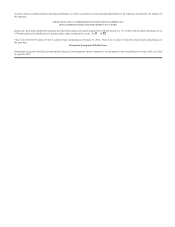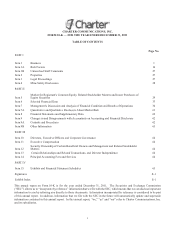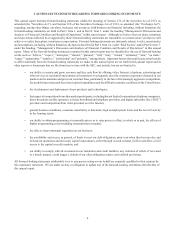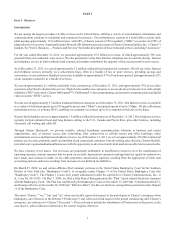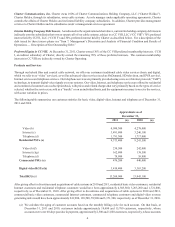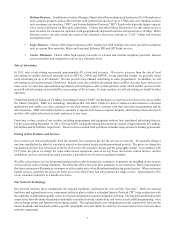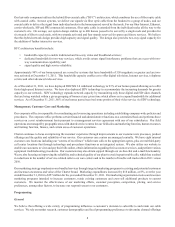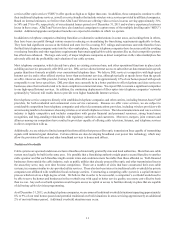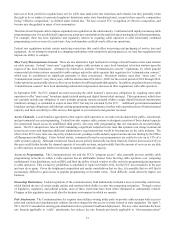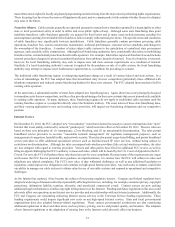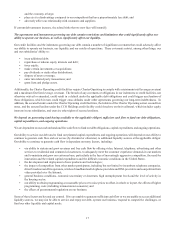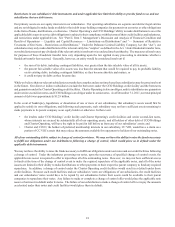Charter 2011 Annual Report Download - page 20
Download and view the complete annual report
Please find page 20 of the 2011 Charter annual report below. You can navigate through the pages in the report by either clicking on the pages listed below, or by using the keyword search tool below to find specific information within the annual report.8
Our last-mile component utilizes the hybrid fiber coaxial cable (“HFC”) architecture, which combines the use of fiber optic cable
with coaxial cable. In most systems, we deliver our signals via fiber optic cable from the headend to a group of nodes, and use
coaxial cable to deliver the signal from individual nodes to the homes passed served by that node. For our fiber Internet, Ethernet,
carrier wholesale, SIP and PRI commercial customers, fiber optic cable is extended from the individual nodes all the way to the
customer's site. On average, our system design enables up to 400 homes passed to be served by a single node and provides for
six strands of fiber to each node, with two strands activated and four strands reserved for spares and future services. We believe
that this hybrid network design provides high capacity and signal quality. The design also provides two-way signal capacity for
the addition of further interactive services.
HFC architecture benefits include:
• bandwidth capacity to enable traditional and two-way video and broadband services;
• dedicated bandwidth for two-way services, which avoids return signal interference problems that can occur with two-
way communication capability; and
• signal quality and high service reliability.
Approximately 98% of our homes passed are served by systems that have bandwidth of 550 megahertz or greater and are two-
way activated at December 31, 2011. This bandwidth capacity enables us to offer digital television, Internet services, telephone
service and other advanced video services.
As of December 31, 2011, we have deployed DOCSIS 3.0 wideband technology to 93% of our homes passed allowing us to offer
faster high-speed Internet service. We have also deployed SDV technology to accommodate the increasing demands for greater
capacity in our network. SDV technology expands network capacity by transmitting only those digital and HD video channels
that are being watched within a given grouping of homes at any given time which allows us to expand bandwidth for additional
services. As of December 31, 2011, 86% of our homes passed received some portion of their video service via SDV technology.
Management, Customer Care and Marketing
Our corporate office is responsible for coordinating and overseeing operations including establishing company-wide policies and
procedures. The corporate office performs certain financial and administrative functions on a centralized basis and performs these
services on a cost reimbursement basis pursuant to a management services agreement with one of our subsidiaries. Our field
operations are managed by geographic areas with shared service centers for our field sales and marketing function, human resources
and training function, finance, and certain areas of customer operations.
Charter continues to focus on improving the customer experience through improvements to our customer care processes, product
offerings and the quality and reliability of our service. Our customer care centers are managed centrally. We have eight internal
customer care locations including our “centers of excellence” which route calls to the appropriate agents, plus several third-party
call center locations that through technology and procedures functions as an integrated system. We also utilize our website to
enable our customers to view and pay their bills online, obtain information regarding their account or services, and perform various
equipment troubleshooting procedures. Our customers may also obtain support through our on-line chat and e-mail functionality.
We are also focusing on improving the reliability and technical quality of our plant to avoid repeat trouble calls, which has resulted
in reductions in the number of service-related calls to our care centers and in the number of trouble call truck rolls in 2011 versus
2010.
Our marketing strategy emphasizes our bundled services through targeted marketing programs to existing and potential customers
and increases awareness and value of the Charter brand. Marketing expenditures increased by $18 million, or 8%, over the year
ended December 31, 2010 to $257 million for the year ended December 31, 2011. Our marketing organization creates and executes
marketing programs intended to increase customers, retain existing customers and cross-sell additional products to current
customers. We monitor the effectiveness of our marketing efforts, customer perception, competition, pricing, and service
preferences, among other factors, to increase our responsiveness to our customers.
Programming
General
We believe that offering a wide variety of programming influences a customer’s decision to subscribe to and retain our cable
services. We rely on market research, customer demographics and local programming preferences to determine channel offerings


